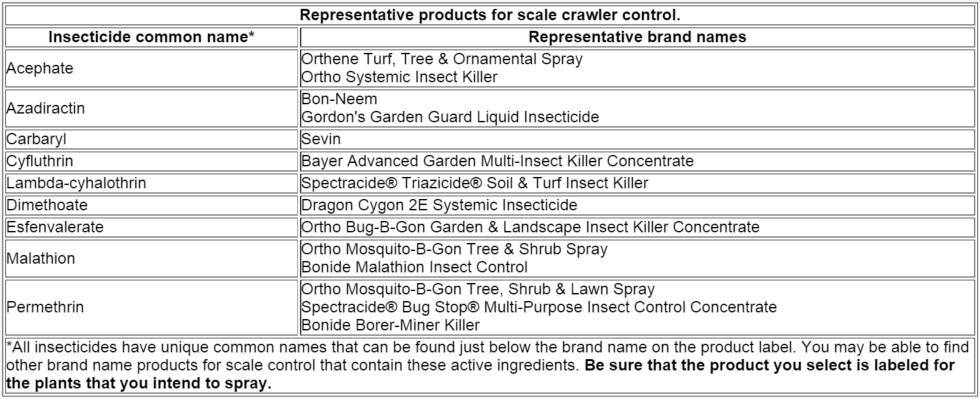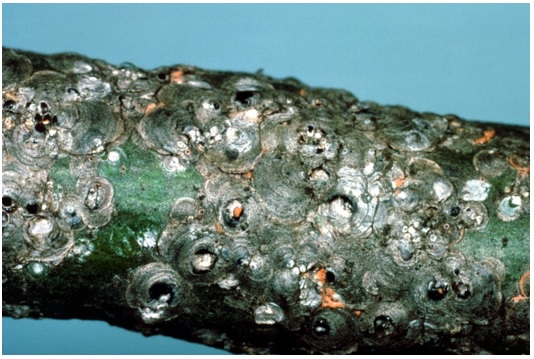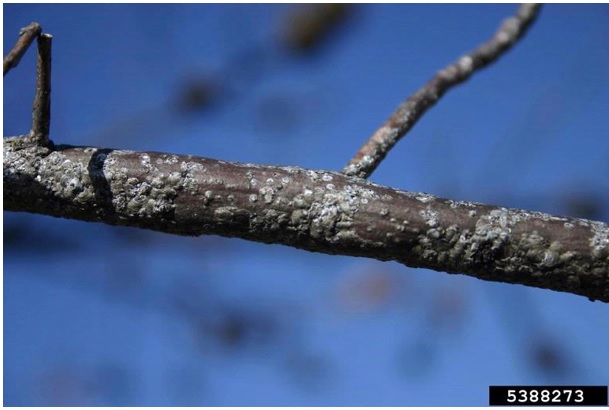Obscure Scale
ENTFACT-432: Obscure Scale | Download PDF
By Jonathan L. Larson, Extension Entomologist and Lee Townsend, Extension Specialist Emeritus
University of Kentucky College of Agriculture
Obscure Scale Fast Facts
- Obscure scale is a small, sap feeding, armored scale pest that can be found on oak, beech, dogwood, hackberry, hickory, maple, pecan, and willow.
- Adult females will have a dirty grey waxy cover that is about 1/8th inch in diameter.
- Symptoms include branch dieback and disfigured bark.
- Management is usually dependent upon treating the immature “crawler” stage in May or July with a pyrethroid or oil-based insecticide. Alternatively, a systemic application of dinotefuran will also provide good control.
Obscure scales are small, armored scale insect pests that can be hard to detect. They can cause leaf drop and branch dieback as they feed. (Photo by Jim Kalisch, University of Nebraska-Lincoln)
Potential Hosts
Obscure scale can be found on oaks (in particular, pin and willow oaks), beech trees, dogwoods, hackberry trees, hickory trees, maples, pecan, and willow. They can be found on the trunk and on the limbs and will infest both young and mature trees.
Symptoms and Pest Description
Scale insects are “sucking pests”, meaning they use a needle like mouth to siphon fluids from plants. As the tree becomes stressed and weakened, you might see leaf drop and branch dieback begin. As the infestation continues, they can be bark disfiguration as the scale creates sunken areas where they have been feeding.
Obscure scale gets its name from its hard to see nature. Upon close inspection of the tree, you might notice what appears to be ash or silver glitter. You might even dislodge layers of scales and waxy armor as you touch the plant. The female obscure scale’s waxy shield is about 1/8th inch in diameter, dirty grey in color, and will have an off-center black cap on top. Underneath of the shield you may find a yellow or cream-colored disc, which is the actual insect.
Life Cycle in Kentucky
This species overwinters as nymphs on the branches of their host tree. Female obscure scale become mature by April or early May, while the males mature through May. Once males emerge, they will mate with females and then perish. Following this, female obscure scales will lay upwards of 50 pink colored eggs. Egg laying and the resulting emergence of crawlers from those eggs can occur over an extended period between early summer until the end of August. The earliest crawlers will often settle nearby and may utilize the waxy coating of older dead scales for protection. Crawlers that emerge later in the season will usually move to un-infested areas, spreading the scale problem throughout the plant. Crawlers will start their own waxy shield when they reach their second instar in the early fall, then will overwinter to renew the mating process the next growing season. There is only one generation per year.
Management
Scales tend to thrive on stressed plants. Following a recommended fertility program and watering regime will promote plant health. However, over-fertilization favors scale buildup. If practical, improve plant sites to reduce stress and promote growth. You can prune out small infestations to try and eliminate the issue or prune out sections of a large scale problem in order to make chemical control more feasible.
There are two options when considering management of obscure scales, doing a systemic treatment or treating the crawlers directly. Whichever you choose, management may take repeated applications over a couple of growing seasons.
Treating with Systemic Insecticides
Dinotefuran (Orthro Tree & Shrub is one possible trade name) can be used against armored scales such as the obscure scale. A systemic insecticide helps to give you control without reliance on broadcast sprays on the plant. This helps keep insecticide residues contained within the plant you wish to protect and helps to ensure the product will affect the pests you are targeting.
Close inspection of branches infested with obscure scale can reveal an ashy like substance or silver glitter. Beneath the waxy cover is the actual insect. William Fountain, University of Kentucky, Bugwood.org
Treating Crawlers Directly
Crawlers are the most susceptible to control stage of a scale insect’s life. Obscure scale crawlers can be challenging to control though since they will utilize the waxy armor left behind by earlier, dead scale insects and then subsequently build their own. To best deal with populations of this scale, you might first prune out the most heavily infested twigs and then monitor for crawler emergence. Once they begin to coat themselves in their waxy armor, insecticide applications have limited to no effect. You can visually check in July and August or you can place pieces of black electrical tape (sticky side out) or double-sided tape near scale populations and monitor the tape for the crawlers and treat following the initial find.
Horticultural oils kill by suffocation or after penetrating over-wintering stages of the insect. Consequently, they may not be effective where several layers of scale coverings have accumulated. Insecticidal soaps are long chain fatty acids that kill susceptible insects through direct contact. Like horticultural oils, they require thorough coverage. Soaps leave no residue so repeated applications may be needed for some pests. These products may burn the foliage of sensitive plants, such as Japanese maple, so check the label for information about the plant species that you intend to treat.
A variety of natural and synthetic insecticides are labeled for use as sprays to control scale crawlers on landscape trees and shrubs. While the residual life of these products is generally longer than oils and soaps, timing, coverage, and precautions on damage to some plant species are very similar to those for oils and soaps.
Below are some options for scale insect crawler control.

Evaluating Control
The success or failure of control efforts may not be readily apparent but here are some things to check.
- Live scales should produce a liquid when mashed, dead scales will be dry and not "bleed" when crushed.
- New foliage should have a healthier appearance once the scale burden has been removed. Buds should break a little earlier than when the plant was infested and expanded leaves should have normal color and turgor.
Revised: 2/21
CAUTION! Pesticide recommendations in this publication are registered for use in Kentucky, USA ONLY! The use of some products may not be legal in your state or country. Please check with your local county agent or regulatory official before using any pesticide mentioned in this publication.
Of course, ALWAYS READ AND FOLLOW LABEL DIRECTIONS FOR SAFE USE OF ANY PESTICIDE!
Images: University of Kentucky Entomology


